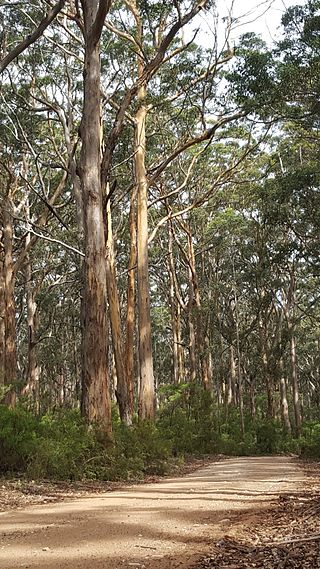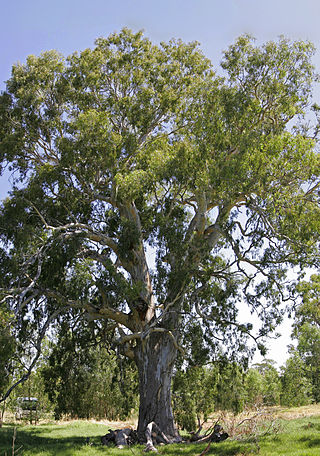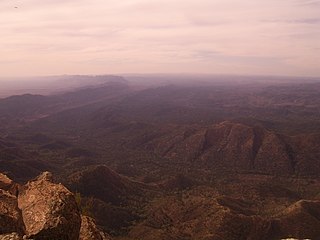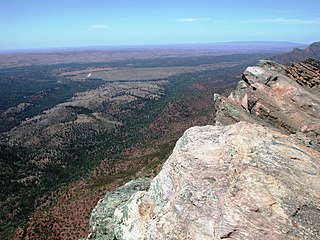
The Ikara–Flinders Ranges National Park, formerly Flinders Ranges National Park, is a national park situated approximately 430 km (270 mi) north of Adelaide. It lies northeast of the small town of Hawker, in the northern central part of South Australia's largest mountain range, the Flinders Ranges, and covers an area of 95,000 ha (370 sq mi) between Hawker and Blinman. It is known for the land formation known as Wilpena Pound, while other well-known features include the Heysen Range and the Brachina and Bunyeroo gorges. The Heysen Trail and Mawson Trail pass through the park.

Eucalyptus diversicolor, commonly known as karri, is a species of flowering plant in the family Myrtaceae and is endemic to the south-west of Western Australia. It is a tall tree with smooth light grey to cream-coloured, often mottled bark, lance-shaped adult leaves and barrel-shaped fruit. Found in higher rainfall areas, karri is commercially important for its timber.

The Flinders Ranges are the largest mountain ranges in South Australia, which starts about 200 km (125 mi) north of Adelaide. The ranges stretch for over 430 km (265 mi) from Port Pirie to Lake Callabonna.

Eucalyptus camaldulensis, commonly known as the river red gum, is a species of flowering plant in the family Myrtaceae, and is endemic to Australia. It is a tree with smooth white or cream-coloured bark, lance-shaped or curved adult leaves, flower buds in groups of seven or nine, white flowers and hemispherical fruit with the valves extending beyond the rim. A familiar and iconic tree, it is seen along many watercourses across inland Australia, providing shade in the extreme temperatures of central Australia.

Hawker is a town and a locality in the Flinders Ranges area of South Australia, 365 kilometres (227 mi) north of Adelaide. It is in the Flinders Ranges Council, the state Electoral district of Stuart and the federal Division of Grey.
The Adnyamathanha are a contemporarily formed grouping of several distinct Aboriginal Australian peoples of the northern Flinders Ranges, South Australia. The ethnonym Adnyamathanha was an alternative name for the Wailpi but the contemporary grouping also includes the Guyani, Jadliaura, Pilatapa and sometimes the Barngarla peoples. The origin of the name is in the words "adnya" ("rock") and "matha".

Wilpena Pound is a natural amphitheatre of mountains located 429 kilometres (267 mi) north of Adelaide, South Australia, Australia in the heart of the Ikara-Flinders Ranges National Park. Its fringe is accessible by a sealed road between the towns of Hawker to the south and Blinman in the northern Flinders Ranges.

Eucalyptus cladocalyx, commonly known as sugar gum, is a species of eucalypt tree found in the Australian state of South Australia. It is found naturally in three distinct populations - in the Flinders Ranges, Eyre Peninsula and on Kangaroo Island.

Blinman is a locality incorporating two towns in the Australian state of South Australia within the Flinders Ranges about 425 kilometres (264 mi) north of the state capital of Adelaide. It includes the highest surveyed town in South Australia, with a population in the 2021 census of 43. It serves as a base for large-acre pastoralists and tourism. Blinman is just north of the Flinders Ranges National Park, 60 kilometres north of Wilpena Pound. It is named after Robert Blinman, the shepherd who discovered its mineral resource.

Harold Pierce Cazneaux, commonly referred to as H. P. Cazneaux, was an Australian photographer; a pioneer whose style had an indelible impact on Australian photographic history. In 1916, he was a founding member of the Pictorialist Sydney Camera Circle. As a regular participator in national and international exhibitions, Cazneaux was unfaltering in his desire to contribute to the discussion about the photography of his times. His career between the Wars established him as "the country's leading pictorial photographer".

St Mary Peak / Ngarri Mudlanha is a mountain located in the Australian state of South Australia on the northwestern side of Ikara. It is the highest peak in the Flinders Ranges and the eighth highest peak in South Australia, with a height of 1,189 metres (3,901 ft). It is located within the Ikara–Flinders Ranges National Park and the gazetted locality of Flinders Ranges, South Australia. It was for a time known as "St Mary's Peak", but was renamed according to guidelines deprecating the use of names implying possession.

Arkaba or Arkaba Station is a part-perpetual lease, part-freehold property located about 20 kilometres (12 mi) north east of Hawker and 72 kilometres (45 mi) south of Blinman in the Flinders Ranges in the state of South Australia,

Rawnsley Bluff is a geological feature in the Australian state of South Australia located in the locality of Flinders Ranges, South Australia and within the boundaries of the Ikara-Flinders Ranges National Park.
Adelaide Bushwalkers is a bushwalking club based in Adelaide, South Australia.
The Kanalla Falls, a waterfall on the Edeowie Creek, is located in the Flinders Ranges in South Australia.
Henry Strong Price, generally known as H.S. Price, or simply Harry Price, was a pioneer sheep pastoralist of South Australia, best known as founder and proprietor of Wilpena Station at Wilpena Pound, now part of the Ikara-Flinders Ranges National Park.

Eucalyptus socialis, commonly known as the red mallee, or grey mallee, is a species of mallee that is endemic to inland Australia.

Flinders Ranges is a locality in the Australian state of South Australia located in the mountain range of the same name, about 380 km (240 mi) north of the state capital of Adelaide, about 86 km (53 mi) north-east of the municipal seat in Quorn and about 131 km (81 mi) north-east of the regional centre of Port Augusta.

County of Hanson is a cadastral unit located in the Australian state of South Australia that covers land in the Flinders Ranges immediately east of the town of Hawker. It was proclaimed on 20 July 1877 and is named after Sir Richard Davies Hanson who served as Premier, Administrator and Chief Justice of South Australia. It has been partially divided in the following sub-units of hundreds – Adams, Arkaba, French, Moralana and Warcowie.



















